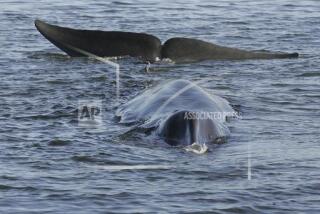Whalers Hoping to Regain Acceptance
- Share via
OSLO — The votes aren’t counted yet--in fact they won’t even be cast until next month. But the hardy men who hunt whales each summer off the rough Norwegian coast are already hoping this will be the year they are finally removed from the rolls of international environmental scourges.
Norway has stirred world passions since 1993, when it permitted its whalers to resume the annual hunt, despite a global moratorium imposed by the International Whaling Commission in 1986.
A few countries, such as Canada, tolerate subsistence whaling by native peoples and Japan conducts “scientific whaling.” But only Norway has gone so far as to let its fishermen openly hunt whales for commercial trade--and Norway has reaped a tempest as a result.
Protesters have flocked to these shores in recent years, attacking abattoirs, scuttling whaling boats in their berths and, in the case of the California-based Sea Shepherd Conservation Society, ramming a Norwegian coast guard ship. (The Sea Shepherd claims that it was rammed by the Norwegian coast guard.)
But this summer, an uncharacteristic peace has prevailed on Norwegian waters. There was one unexplained fire aboard a Norwegian craft early in the season. But aside from that possible act of sabotage, the usual fleets of protesters have not appeared.
“I don’t think they have much support anymore, because they told a story that wasn’t true,” says Jan Odin Olavsen, 48, a whaler from the northern community of Laknas. His five-man boat filled its 17-whale quota in one week this summer.
“There are a lot of whales,” he concludes. “The stock is not threatened at all.”
Here in Oslo, the major Norwegian environmental groups say Olavsen is right: It is now safe to hunt one species of whale, the minke, which grows to 32 feet in length. The minke is the only whale that may be hunted under Norwegian regulations.
Norway won an important symbolic victory earlier this year when a majority of delegates to the triennial Convention on International Trade in Endangered Species, held in Zimbabwe, voted to allow limited trading in such minke products as meat and blubber.
The minke remains on the endangered list, since removing it requires a two-thirds vote of delegates. But whaling interests believe that the convention’s 57-51 vote in Norway’s favor--a first--will give an important nudge to the all-important International Whaling Commission, scheduled to meet in Monaco in October.
“I’m a bit uncertain, but what we may be seeing is a chance, for the first time in 10 or 15 years, to find a compromise between the whaling nations and the anti-whaling nations,” says Norwegian Whaling Commissioner Kaare Bryn.
Bryn admits that Norway had much to do with the near-extinction earlier in the century of the huge blue whale and other species. But he argues that it has been decades since Norway has practiced the industrial techniques that almost wiped out the great whales.
Today, he says, Norway’s 150 or so whalers are all fishermen, whaling for just a few weeks each summer under government supervision. They operate small, coastal fishing boats, not huge, floating factories. And their estimate that there are about 110,000 minke whales in the northeastern Atlantic has been accepted by the International Whaling Commission. Norway’s 1997 quota of 580 minke whales is an acceptable fraction of that population, Bryn says.
Some people are listening. In January, IWC commissioners reportedly discussed how to reach accommodation between whaling nations and those--like the United States--that oppose the hunt. One proposal was to keep the moratorium on factory whaling but to lift the ban for small, Norwegian-style boats.
This prospect alarms environmentalists. Richard Page, a whale campaigner at Greenpeace UK, said his group believes that if the ban on minke whaling is lifted at Norway’s behest, it will throw open the doors to over-whaling of rarer species by less conscientious nations.
Asked why Greenpeace didn’t come to Norway to protest this summer, Page said that since a new government was establishing itself in Oslo, his group wanted to concentrate its lobbying efforts in the corridors of the capital, not on the waves of the northern coast. He said Greenpeace might return to its waterborne tactics next summer.
More to Read
Sign up for Essential California
The most important California stories and recommendations in your inbox every morning.
You may occasionally receive promotional content from the Los Angeles Times.










